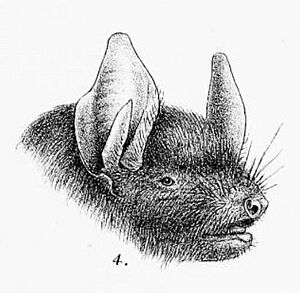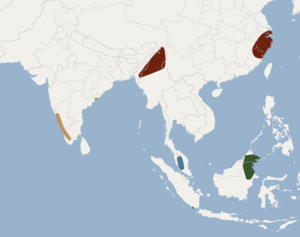Burmese whiskered myotis facts for kids
Quick facts for kids Burmese whiskered myotis |
|
|---|---|
 |
|
| Conservation status | |
| Scientific classification | |
| Genus: |
Myotis
|
| Species: |
montivagus
|
 |
|
| Burmese whiskered myotis range in red (eastern Chinese range likely erroneous) | |
The Burmese whiskered myotis or Burmese whiskered bat (Myotis montivagus) is a type of vesper bat. These bats are found in parts of Asia. You can find them in countries like China, India, Myanmar, Laos, and Vietnam.
Contents
About the Burmese Whiskered Bat
The Burmese whiskered bat is a small, furry mammal. It belongs to a group of bats called Myotis, which means "mouse-eared." This name comes from their ears, which often look like those of a mouse. Like other bats, they are very important for their ecosystems.
How Scientists Study Bats
For a long time, scientists thought this bat lived in many places across Asia. They believed its home stretched from India all the way to Borneo. But in 2013, a new study changed this idea. Scientists looked closely at the bats' skulls and teeth. They found important differences between bats from different areas.
Discovering New Bat Species
Because of these differences, scientists realized there were actually several distinct species. What was once thought to be one widespread bat was split into four different ones:
- The Burmese whiskered myotis (M. montivagus)
- Peyton's myotis (M. peytoni), found only in India
- The Malaysian whiskered myotis (M. federatus), found only in Peninsular Malaysia
- The Bornean whiskered myotis (M. borneoensis), found only in Borneo
This shows how new research can help us understand the natural world better.
Where These Bats Live
The Burmese whiskered myotis lives in specific parts of Asia. Its main home is from northeastern India up to southern China. It also lives south into northern Myanmar. There are also some bats in Laos and Vietnam. However, some scientists think these might be a slightly different group.
Bat Habitats
These bats usually live in tropical mountain forests. This means they prefer forests found on mountains in warm regions. In Vietnam, they have also been seen in lower areas. This includes places like farms and open fields. Bats often roost in caves during the day.
Status of the Burmese Whiskered Myotis
Scientists don't know much about the Burmese whiskered myotis. Because of this, it is listed as "Data Deficient" by the IUCN Red List. This means there isn't enough information to know if the species is safe or in danger. More research is needed to understand their numbers.
Threats to Bats
Even though we don't know much, these bats might be at risk. They could be threatened by the loss of their homes. This includes caves where they sleep and the forests where they find food. Protecting these places is important for the bats' future.


